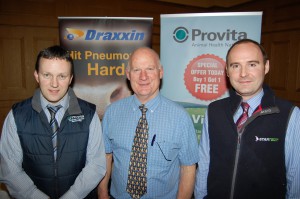 Leading veterinarian Roger Blowey spoke at Provita/Pfizer Animal Health-hosted farmers’ meetings in Coleraine and Portadown. This was followed on with meetings in Clonmel and Cork. Courtesy of his presentations, Roger highlighted the growing challenge of hoof related problems on dairy farms and the ways by which farmers can get on top of this issue.
Leading veterinarian Roger Blowey spoke at Provita/Pfizer Animal Health-hosted farmers’ meetings in Coleraine and Portadown. This was followed on with meetings in Clonmel and Cork. Courtesy of his presentations, Roger highlighted the growing challenge of hoof related problems on dairy farms and the ways by which farmers can get on top of this issue.
In light of the recent development of non healing hoof lesions, the renowned ‘foot specialist’ went on to point out that farmers should create a simple system to allow daily foot-bathing, as frequent foot-bathing is now essential. They must also ensure that the product is used at the correct concentration, changed regularly – also remembering to footbath dry cows and heifers.
Roger Blowey now tends to treat animals with non healing lesions on farms which have a history of such cases – and which have failed to heal – with aggressive antibiotic therapy both topically and systemically. Even then a significant proportion of cases will fail to heal completely, partly as a result of irreversible damage to the underlying pedal bone. In such cases there may a requirement to require amputate the claw or cull the cow.
Roger also pointed out that the average cost of lameness in terms of milk loss is 400 litres per lactation and sole ulcers can half the lifespan of cows. These milk losses can occur two months before the cow goes lame. What’s more, the most critical time influencing lameness is the period around calving and good care of the freshly calved cow within a well managed transition group is, therefore, strongly advised. Indeed, Roger pointed out that freshly calved cows and heifers will suffer 240 aggressive interactions on a daily basis. These will be taking place at a time when ligaments within the hoof are softer and hoof growth has almost stopped.
Adequate feeding space, minimal standing times and an ideal cow to cubicle ratio: 9 cows to 10 cubicles – are also very important, in thre context of reducing lameness problems. Cubicle comfort is another important factor in helping to reduce these issues. Minimising trauma to the hoof by having good, underfoot conditions is important. For example, clean yards with a sure footing for stock and minimising the amount of twisting and turning which animals have to undertake will also help to reduce the burden of lameness.
In his conclusions Roger Blowey made the following points:
Digital dermatitis has now become extremely important, so daily foot bathing is no longer optional – it is essential!
Remember that lameness is multi-factorial. It is unlikely that any one preventive measure alone will lead to its control.
Systemic antimicrobial therapy may be more needful on some farms now that in the past, not only in the treatment of foul but also to minimise the impact of non-healing lesions.
The Provita perspective
Provita’s Tommy Armstrong also spoke at the meetings. He stressed the need for daily footbathing on local dairy farms in tandem with the regular footbathing of dry cows and in calf heifers, as a means of getting on top of digital dermatitis.
“I would also encourage farmers to wash cows’ feet in the milking parlour, on a weekly basis. This will allow them identify digital dermatitis lesions at an early stage, which can then be sprayed effectively with our Combat Hoof Spray or Konquest gel applied.
Tommy concluded:
“Digital Dermatitis can be likened to Mastitis of the foot. Farmers spray udders at every milking: so why not take the same approach, where foot bathing is concerned.
“Case studies confirm that using Konquest, Combat and Hoofsure Endurance in a daily footbath resulted in a substantial reduction in lameness over time.”
The final presentation of the evening was given by Pfizer Animal Health’s Mark Little, who discussed the responsible use of antibiotics.